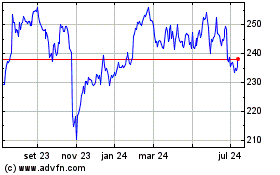Stock Market News for November 1, 2012 - Market News
01 Novembro 2012 - 7:06AM
Zacks
It was business as usual for
markets on Wednesday following two days of closure due to Hurricane
Sandy and it ended almost flat yesterday. This was for the first
time that markets were closed for two consecutive days due to
weather problems since 1888. Meanwhile, all three major indices
fell sharply for the month, with the Dow tumbling nearly 2.5%.
Homebuilder stocks were the major gainer among the S&P 500
industry group.
The Dow Jones Industrial Average (DJI) slipped 0.1% to close the
day at 13,096.46. The Standard & Poor 500 (S&P 500) edged
up 0.02% to finish yesterday’s trading session at 1,412.16. The
tech-laden Nasdaq Composite Index dropped 0.4% to end at 2,977.23.
The fear-gauge CBOE Volatility Index (VIX) gained 4.4% to settle at
18.60. Consolidated volumes on the New York Stock Exchange,
American Stock Exchange and Nasdaq were roughly 6.3 billion shares,
lower than the daily average of 6.51 billion shares. Advancers
outpaced the decliners on the NYSE; as for 56% stocks that gained,
41% stocks closed in the red. For the month, the Dow tumbled 2.5%,
the S&P 500 dropped 2.0% and the Nasdaq dropped 4.5% following
lower-than-expected earnings from blue-chips companies and gloomy
global economic conditions.
Benchmarks reopened trading after a two-day closure caused by
Hurricane Sandy. Larry Leibowitz, chief operating officer of NYSE
Euronext (NYSE:NYX), said "The open was a positive relief after
four days of sitting on edge," and added "No matter how much
planning you do, you can't foresee that kind of flooding".
Looking at the economic impact of Sandy, various forecasts predict
the storm will cause damages of up to $50 billion. Earlier, Eqecat,
a disaster modeling company, had projected that the U.S. economy
may incur losses between $10 billion and $20 billion. Separately,
Kinetic Analysis Corp is projecting losses will reach $25 billion;
while its research and development director said insured losses
could amount to between $7 billion to $8 billion. Forecasting firm
IHS Global Insight estimates that property damages may touch $20
billion and another $10 billion to $30 billion will be incurred as
lost business. The storm has already left about 8 million houses
without power and thousand of flights have been cancelled. Also,
about 70% of East Coast oil refineries were forced to remain
closed. Moreover, New York has been severely affected and this
region substantially contributes to the nation’s economic
output.
A batch of companies reported their earnings yesterday. General
Motors Company’s (NYSE:GM) shares surged 9.6% following
better-than-expected quarterly results. According to General
Motors, the company targeted a rebound from loss to a breakeven
level in its European operations. On Tuesday, Ford Motor Company
(NYSE:F) had posted its quarterly results; wherein it reported a
17.6% year-on-year surge in its third quarter earnings. The
company’s shares surged 8.2% yesterday.
In economic news, Automatic Data Processing’s (NASDAQ:ADP) National
Employment report stated that the U.S. private sector employment
increased by 88,200 in the month of September from 76,400 in the
month of August. The September report was based on their new
methodology. According to the report, large businesses added 35,800
employees, whereas medium and small business added 28,000 and
24,300 employees, respectively, in the month of September. Service
sector jobs increased by 97,500, while goods producing jobs
decreased by 9,300.Construction companies added 9,100 jobs and
employment in professional and business services increased by
17,400.
Meanwhile, the Chicago Purchasing Managers index edged up 0.2
points to 49.9 in the month of October from 49.7 in the month of
September. This was below consensus estimates of 51.4. According to
the report, five of the seven business activities reflected
weakness. Expansion in employment touched its lowest level in 33
months.
The technology sector was the major loser among the S&P 500
group of companies with Apple Inc. (NASDAQ:AAPL) losing 1.4%.
Apple’s shares tumbled over 15% from an all-time high reached in
mid-September. Stocks such as Hewlett-Packard Company (NYSE:HPQ),
Intel Corporation (NASDAQ:INTC), SanDisk Corporation (NASDAQ:SNDK),
NVIDIA Corporation (NASDAQ:NVDA) and Texas Instruments Incorporated
(NASDAQ:TXN) lost 1.7%, 1.5%, 1.1%, 0.6% and 2.2%,
respectively.
The SPDR S&P Homebuilders (XHB) surged 1.9% and was the major
gainer among the S&P 500 group of companies. Stocks such as The
Home Depot, Inc. (NYSE:HD), Lowe's Companies, Inc. (NYSE:LOW),
PulteGroup, Inc. (NYSE:PHM), M.D.C. Holdings, Inc. (NYSE:MDC) and
D.R. Horton, Inc. (NYSE:DHI) gained 2.2%, 3.3%, 0.4%, 1.1% and
1.0%, respectively.
APPLE INC (AAPL): Free Stock Analysis Report
AUTOMATIC DATA (ADP): Free Stock Analysis Report
D R HORTON INC (DHI): Free Stock Analysis Report
FORD MOTOR CO (F): Free Stock Analysis Report
GENERAL MOTORS (GM): Free Stock Analysis Report
HOME DEPOT (HD): Free Stock Analysis Report
HEWLETT PACKARD (HPQ): Free Stock Analysis Report
INTEL CORP (INTC): Free Stock Analysis Report
LOWES COS (LOW): Free Stock Analysis Report
MDC HLDGS (MDC): Free Stock Analysis Report
NVIDIA CORP (NVDA): Free Stock Analysis Report
PULTE GROUP ONC (PHM): Free Stock Analysis Report
SANDISK CORP (SNDK): Free Stock Analysis Report
TEXAS INSTRS (TXN): Free Stock Analysis Report
To read this article on Zacks.com click here.
Zacks Investment Research
Automatic Data Processing (NASDAQ:ADP)
Gráfico Histórico do Ativo
De Jun 2024 até Jul 2024

Automatic Data Processing (NASDAQ:ADP)
Gráfico Histórico do Ativo
De Jul 2023 até Jul 2024
